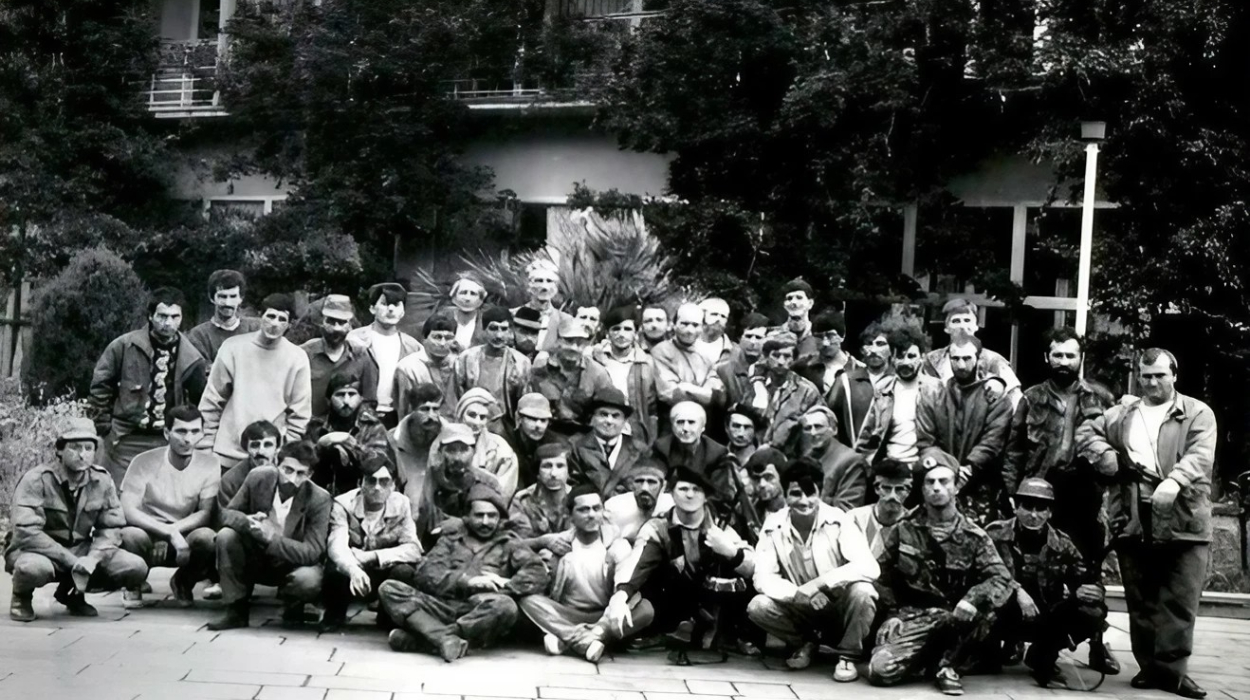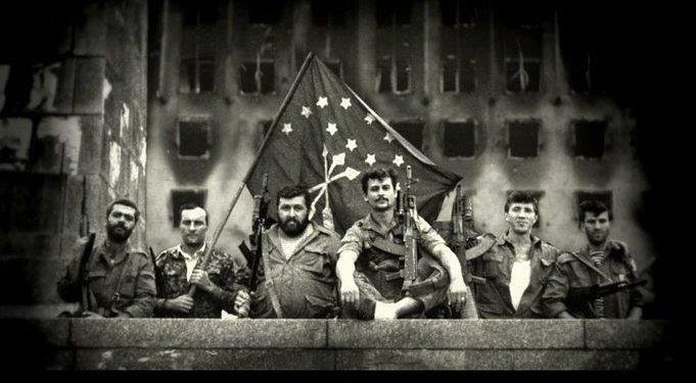How nations united: Formation of the Confederation of Caucasian Peoples

Volunteers | Confederation of Mountain Peoples of the Caucasus. Abkhazia, 1993
Everyone who is somehow familiar with the history of the Patriotic War of the people of Abkhazia could not help but hear about the Assembly of Mountain Peoples of the Caucasus, which was soon renamed the Confederation. This is no accident: the organization made a significant contribution to the victory of the Abkhaz army over the Georgian occupiers. In particular, it became a center for the formation of a voluntary movement in Abkhazia.
Prototype of the Mountain Republic
The Assembly of Mountain Peoples of the Caucasus was established three years before the start of Patriotic war of the people of Abkhazia, on August 25, 1989. On this day in Sukhum in the conference hall of the Council of Ministers of Abkhazia the first congress of the Assembly was held. The event gathered over 500 delegates from Abkhazia and the republics of the North Caucasus.
On August 25-26, 1989, the first congress of the Assembly (Confederation) of the Mountain Peoples of the Caucasus was held in Sukhum.
“The Georgian population of the capital that day decided to stay at home, and the top leadership of Abkhazia, consisting of persons of Georgian nationality, urgently left for Tbilisi for a consultation,” Yuri Kuraskua, editor-in-chief of the newspaper “Republic of Abkhazia” writes about those events.
According to Kuraskua, the pro-Georgian authorities in Abkhazia felt a force in the Caucasian association that could impede the implementation of their secret fascist plans. During this period, Georgia already intended to secede from the USSR along with the Abkhaz Autonomous Soviet Socialist Republic and the South Ossetian Autonomous Region that were part of it, regardless of the position of the Abkhaz and South Ossetian peoples.
+ Treaty on the Confederative Union of the Mountain Peoples of the Caucasus (1991)
+ Abkhazia, Georgia and the Caucasus Confederation, by Stanislav Lakoba
Relations between Sukhum and Tbilisi at that time were particularly tense and even resulted in an open confrontation between the parties. That was in July 1989. Then, after inter-ethnic clashes in the Abkhaz capital, a 30,000-strong convoy from Georgia tried to break into Sukhum, but was stopped in Ochamchira on a bridge over the Aaldzga River.
These events preceded the formation of the Assembly of Mountain Peoples of the Caucasus and became the reason for its creation. The Abkhaz felt that trouble was approaching, and thus tried to demonstrate to Georgia that they were not alone, that the peoples of the Caucasus would support the Abkhaz people and, if necessary, respond to Tbilisi’s aggression.
Musa Shanibov interviewed by Abkhaz TV during the war with Georgia, 1992-1993
Politician and public figure Musa Shanibov headed the association. Later, he will confirm that the creation of the Confederation of Mountain Peoples of the Caucasus was necessary to defend the national interests of Abkhazia, which were infringed upon by the Georgian authorities.
The name of the Caucasian association, its structure and spirit became a reference to the Mountain Republic, proclaimed in 1918, which then included the republics of the North Caucasus and Abkhazia. In October 1990, the Assembly declared itself the successor of the Mountain Republic.

The leadership of the the North Caucasian Mountain Republic with the [Circassian] leaders of the Turkish Army in the North Caucasus, 1919.
In November 1991, at the III Congress of the organization in Sukhum, the Assembly was transformed into the Confederation of Mountain Peoples of the Caucasus. Representatives of 12 peoples (Abkhaz, Abaza, Avars, Adyghes (Circassians), Chechens, Balkars, Dargins, Karachais, Kumyks, Lezgins, Laks, Ossetians) at the same time signed the Treaty and adopted the Declaration on the Confederate Union of Mountain Peoples of the Caucasus. They also decided to form the Caucasian Parliament, the Arbitration Court, the Defense Committee and determined the capital of Abkhazia, the city of Sukhum, as the headquarters of the Confederation.

Clipping from the newspaper of the military headquarters of the Confederation of the Peoples of the Caucasus.
The Confederation of Mountain Peoples of the Caucasus defined itself as a “sovereign national-state entity.” The decisions of the organization’s parliament were advisory in relation to the official leaderships of the republics that made up the Confederation.
In October 1992, when hostilities were already taking place in Abkhazia, the word “mountain” was deleted from the name of the organization. The association was transformed into the Confederation of the Peoples of the Caucasus (CPC), since the Cossacks of the South of Russia, which also advocated the interests of the Abkhaz people, were also accepted into it.
We are the Confederates!
Tbilisi initially did not attach serious importance to the Caucasian association, declaring it a “paper tiger.”
In Abkhazia, on the contrary, they looked at the unification with great hope. As journalist Vitaliy Sharia recalls, the Abkhaz understood that they had to be prepared for serious trials, and therefore the support of the republics of the Caucasus was necessary.
A call to the Confederates of the Mountain Peoples of the Caucasus to support Abkhazia in the war with Georgia.
From the first days of its existence, the Assembly organized a variety of cultural events, be it mourning events in Sukhum, dedicated to the Day of Remembrance of the Victims of the Caucasian War, or the Days of Abkhaz-Adyghe Culture, which took place in Sukhum right before the war in July. At the same time, the organization “was created with the expectation of a very different development of events,” says Sharia.
The journalist notes that the first two congresses of the Assembly were held in the Abkhaz capital without attracting a large number of people. And the third congress on November 1-2, 1991 turned out to be so numerous in terms of the number of participants that it took place at the Abkhaz Drama Theater.
The events that followed shortly showed the full strength and power of the Confederation, which made a significant contribution to the victory of the Abkhaz army in the PWPA.
Meeting of the Parliament of the Confederation of Peoples of the Caucasus in Pitsunda.
From the first days of the war in Abkhazia, it was the Confederation of Mountain Peoples of the Caucasus that began to gather volunteers in all the republics of the North Caucasus and send them to defend the people of Abkhazia fighting for freedom and independence.


Messages from the President of the Confederation of Peoples of the Caucasus Musa Shanibov “To the descendants of the peoples of the Caucasus”
Already on the second day of the war in Abkhazia on August 15, the first group of Confederate volunteers, led by Sultan Sosnaliev, a professional soldier who headed the Self-Defense Committee of the Confederation of Mountain Peoples of the Caucasus, arrived in Gudauta, which remained under the control of the Abkhaz authorities.

Newspaper of the military headquarters of the Confederation of Peoples of the Caucasus, Gudauta 1992-1993
At an extraordinary session of the CPC parliament on August 18 in the capital of Chechnya, the city of Grozny, it was decided to provide assistance to Abkhazia. The organization began gathering new volunteer groups. As a result, volunteers from the republics of the North Caucasus, the South of Russia and the Abkhaz Diaspora abroad, including from Turkey, Jordan, Syria, Canada and other countries, began to come to the help of the Abkhaz people.

Circassian Volunteers
The Confederation has announced that it is at war with Georgia. Abkhaz historians emphasize this fact as having a great influence on the formation of the Abkhaz resistance. This had a sobering effect on the leadership of Georgia, which on this occasion even sent a complaint to the UN.
In October 1992, Musa Shanibov, President of the organization, came to Abkhazia. He created the operational headquarters of the Confederation in Gudauta. The headquarters became the organizing force for all the Confederates, from here they were sent to the forefront of the Abkhaz army.

Anna Broydo and volunteers in front of the headquarters of the Confederation of the Peoples of the Caucasus, Gudauta, 1992-1993
“I believe that it was the position of the Confederation of Mountain Peoples of the Caucasus that did not allow the elimination of the Abkhaz people!” - the first President of Abkhazia, Vladislav Ardzinba, will later say about the CPC.
After the Patriotic War of the people of Abkhazia, the Confederation of the Peoples of the Caucasus did not speak directly on its behalf in subsequent military conflicts. At a session of the organization’s parliament in 1998, it was decided to temporarily suspend the activities of the Confederation pending a renewal request from one of the peoples. This actually was the end of the work of the CPC.
+ Heeding the Call of the Heart: Volunteers in the Patriotic War of the People of Abkhazia
+ Bodzhgua on Gena Kardanov: a real tough guy
+ Military Aspects of the War. The Battle for Gagra (The Turning-point), by Dodge Billingsley
Source: Abaza.org